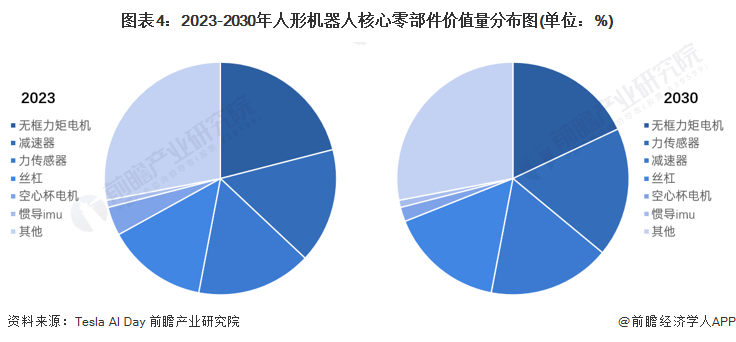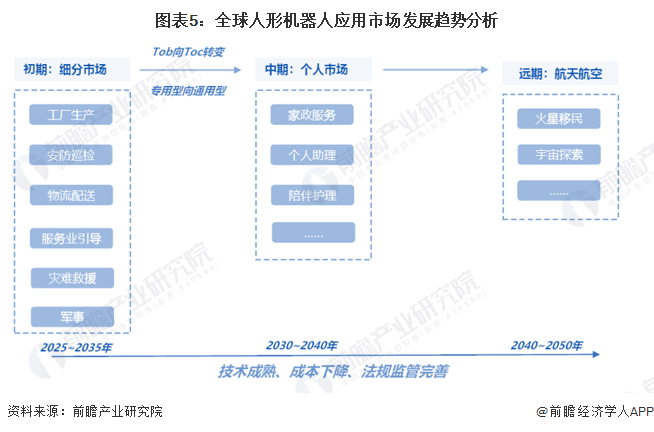 Technology peripherals
Technology peripherals
 AI
AI
 Analysis of market status and development trends of China's humanoid robot industry in 2023. The application market will break through from segmented fields to general-purpose
Analysis of market status and development trends of China's humanoid robot industry in 2023. The application market will break through from segmented fields to general-purpose
Analysis of market status and development trends of China's humanoid robot industry in 2023. The application market will break through from segmented fields to general-purpose
Major listed companies in the humanoid robot industry: (01810.HK);(002472.SZ);(688160.SH);(603728.SH);(300660.SZ);(300969.SZ );(688017.SH);(002896.SZ);(300124.SZ);Qinchuan Machine Tool(000837.SZ);(300718.SZ);(002338.SZ);(002747.SZ) etc.
Core data of this article: China's humanoid industry industry chain, China's humanoid core parts value distribution, China's humanoid robot core parts localization space
The quasi-direct drive solution is expected to become the first choice for some joints
The current solution uses a traditional rigid actuator structure, which is characterized by high accuracy, but the power density cannot reach the level of biological muscles, the impact resistance is average, and it is not suitable for complex geographical environments. In addition to rigid actuators, there are also elastic actuators, quasi-direct drive and other solutions. The control algorithm will be complex and the accuracy is average, but the safety and efficiency are significantly improved. Among them, the quasi-direct drive solution is used more frequently in some four-legged dog and humanoid robot solutions. many.
Compared with the rigid drive solution (frameless torque motor reducer, force sensor encoder), the quasi-direct drive solution mostly uses a planetary reducer magnetic encoder with a low reduction ratio of the direct drive motor, which does not require an expensive force sensor. The ring directly realizes force control, so it is suitable for occasions with high requirements for force control accuracy, fast response and impact resistance. At present, the foreign UCLA robot Artemis has independently developed four quasi-direct drive modules for hip joints.

Dexterous hands are expected to improve dexterity through improved transmission and drive methods
Tesla’s dexterous hand currently uses a worm gear under-drive solution, but the dexterous hand has a richer configuration plan. According to the driving method, it covers the full-driven and under-driven scheme. The under-driven scheme is commonly used. The number of motors is less than the joint degrees of freedom. The system is small in size, light in weight, low in cost, and has the advantages of flexibility to resist external impacts; according to mechanical transmission In terms of mode, it can also be divided into connecting rod, worm gear, ball screw, and belt drive.

Innovation and progress in chip technology promote the development of humanoid robots
Humanoid robots need to integrate a variety of sensors, actuators, computer vision, speech recognition and control systems and other equipment, and need to design complex motion planning and control algorithms. These devices and algorithms require chips with strong computing power, low power consumption, small size, and high integration. Therefore, as the core component of a humanoid robot, the chip directly determines the performance and functionality of the robot. In addition, the chip can also improve the performance and efficiency of the robot through hardware acceleration, neural network calculations, etc., and achieve higher-level functions, such as face recognition, voice translation, emotional analysis, etc. Therefore, innovation and progress in chip technology will promote the development of the humanoid robot industry.

Frameless torque motors, reducers and force sensors will maintain high value quantities
According to data from Tesla AI Day, taking Tesla Optimus as an example, the top three core components of humanoid robots in value in 2023 are frameless torque motors, reducers and force sensors; and in 2030, frameless torque motors The value share of force sensors and reducers has decreased, while the value share of force sensors and reducers has increased. Force sensors will surpass reducers and rank second, and the combined share of the three will still exceed 50%.

The humanoid robot application market will break through from niche areas to general purpose
Referring to autonomous driving, it took more than 5 years to iterate from L1 to L3, and it will still take time for fully autonomous driving to L5. The maturity of humanoid robots is also gradual. They can be commercialized first in market segments, such as factory production, security inspections, logistics distribution, service industry guidance, rescue, military, etc. They have a single function in the initial stage, and then gradually mature into general-purpose robots. , converted from Tob to Toc, entering markets such as housekeeping; in the further future, humanoid robots are expected to be used in the aerospace field.

For more detailed research and analysis on this industry, please see the Qianzhan Industry Research Institute.
At the same time, Qianzhan Industry Research Institute also provides solutions such as consulting, consulting, etc. Quoting the content of this article in any public information disclosure such as prospectuses and company annual reports requires formal authorization from the Qianzhan Industry Research Institute.
More in-depth industry analysis is available in [Forward-looking Economist APP], and you can also communicate and interact with 500 economists/senior industry researchers.
The above is the detailed content of Analysis of market status and development trends of China's humanoid robot industry in 2023. The application market will break through from segmented fields to general-purpose. For more information, please follow other related articles on the PHP Chinese website!

Hot AI Tools

Undresser.AI Undress
AI-powered app for creating realistic nude photos

AI Clothes Remover
Online AI tool for removing clothes from photos.

Undress AI Tool
Undress images for free

Clothoff.io
AI clothes remover

AI Hentai Generator
Generate AI Hentai for free.

Hot Article

Hot Tools

Notepad++7.3.1
Easy-to-use and free code editor

SublimeText3 Chinese version
Chinese version, very easy to use

Zend Studio 13.0.1
Powerful PHP integrated development environment

Dreamweaver CS6
Visual web development tools

SublimeText3 Mac version
God-level code editing software (SublimeText3)

Hot Topics
 1375
1375
 52
52
 I Tried Vibe Coding with Cursor AI and It's Amazing!
Mar 20, 2025 pm 03:34 PM
I Tried Vibe Coding with Cursor AI and It's Amazing!
Mar 20, 2025 pm 03:34 PM
Vibe coding is reshaping the world of software development by letting us create applications using natural language instead of endless lines of code. Inspired by visionaries like Andrej Karpathy, this innovative approach lets dev
 Top 5 GenAI Launches of February 2025: GPT-4.5, Grok-3 & More!
Mar 22, 2025 am 10:58 AM
Top 5 GenAI Launches of February 2025: GPT-4.5, Grok-3 & More!
Mar 22, 2025 am 10:58 AM
February 2025 has been yet another game-changing month for generative AI, bringing us some of the most anticipated model upgrades and groundbreaking new features. From xAI’s Grok 3 and Anthropic’s Claude 3.7 Sonnet, to OpenAI’s G
 How to Use YOLO v12 for Object Detection?
Mar 22, 2025 am 11:07 AM
How to Use YOLO v12 for Object Detection?
Mar 22, 2025 am 11:07 AM
YOLO (You Only Look Once) has been a leading real-time object detection framework, with each iteration improving upon the previous versions. The latest version YOLO v12 introduces advancements that significantly enhance accuracy
 Sora vs Veo 2: Which One Creates More Realistic Videos?
Mar 10, 2025 pm 12:22 PM
Sora vs Veo 2: Which One Creates More Realistic Videos?
Mar 10, 2025 pm 12:22 PM
Google's Veo 2 and OpenAI's Sora: Which AI video generator reigns supreme? Both platforms generate impressive AI videos, but their strengths lie in different areas. This comparison, using various prompts, reveals which tool best suits your needs. T
 Google's GenCast: Weather Forecasting With GenCast Mini Demo
Mar 16, 2025 pm 01:46 PM
Google's GenCast: Weather Forecasting With GenCast Mini Demo
Mar 16, 2025 pm 01:46 PM
Google DeepMind's GenCast: A Revolutionary AI for Weather Forecasting Weather forecasting has undergone a dramatic transformation, moving from rudimentary observations to sophisticated AI-powered predictions. Google DeepMind's GenCast, a groundbreak
 Is ChatGPT 4 O available?
Mar 28, 2025 pm 05:29 PM
Is ChatGPT 4 O available?
Mar 28, 2025 pm 05:29 PM
ChatGPT 4 is currently available and widely used, demonstrating significant improvements in understanding context and generating coherent responses compared to its predecessors like ChatGPT 3.5. Future developments may include more personalized interactions and real-time data processing capabilities, further enhancing its potential for various applications.
 Which AI is better than ChatGPT?
Mar 18, 2025 pm 06:05 PM
Which AI is better than ChatGPT?
Mar 18, 2025 pm 06:05 PM
The article discusses AI models surpassing ChatGPT, like LaMDA, LLaMA, and Grok, highlighting their advantages in accuracy, understanding, and industry impact.(159 characters)
 o1 vs GPT-4o: Is OpenAI's New Model Better Than GPT-4o?
Mar 16, 2025 am 11:47 AM
o1 vs GPT-4o: Is OpenAI's New Model Better Than GPT-4o?
Mar 16, 2025 am 11:47 AM
OpenAI's o1: A 12-Day Gift Spree Begins with Their Most Powerful Model Yet December's arrival brings a global slowdown, snowflakes in some parts of the world, but OpenAI is just getting started. Sam Altman and his team are launching a 12-day gift ex



